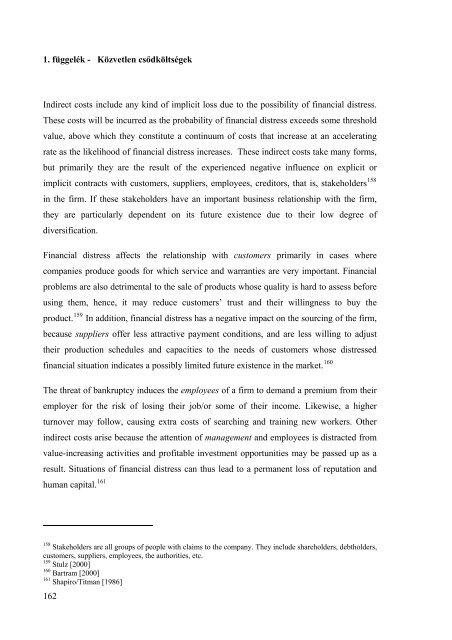értekezés - Budapesti Corvinus Egyetem
értekezés - Budapesti Corvinus Egyetem
értekezés - Budapesti Corvinus Egyetem
Create successful ePaper yourself
Turn your PDF publications into a flip-book with our unique Google optimized e-Paper software.
1. függelék - Közvetlen csődköltségek<br />
Indirect costs include any kind of implicit loss due to the possibility of financial distress.<br />
These costs will be incurred as the probability of financial distress exceeds some threshold<br />
value, above which they constitute a continuum of costs that increase at an accelerating<br />
rate as the likelihood of financial distress increases. These indirect costs take many forms,<br />
but primarily they are the result of the experienced negative influence on explicit or<br />
implicit contracts with customers, suppliers, employees, creditors, that is, stakeholders 158<br />
in the firm. If these stakeholders have an important business relationship with the firm,<br />
they are particularly dependent on its future existence due to their low degree of<br />
diversification.<br />
Financial distress affects the relationship with customers primarily in cases where<br />
companies produce goods for which service and warranties are very important. Financial<br />
problems are also detrimental to the sale of products whose quality is hard to assess before<br />
using them, hence, it may reduce customers’ trust and their willingness to buy the<br />
product. 159 In addition, financial distress has a negative impact on the sourcing of the firm,<br />
because suppliers offer less attractive payment conditions, and are less willing to adjust<br />
their production schedules and capacities to the needs of customers whose distressed<br />
financial situation indicates a possibly limited future existence in the market. 160<br />
The threat of bankruptcy induces the employees of a firm to demand a premium from their<br />
employer for the risk of losing their job/or some of their income. Likewise, a higher<br />
turnover may follow, causing extra costs of searching and training new workers. Other<br />
indirect costs arise because the attention of management and employees is distracted from<br />
value-increasing activities and profitable investment opportunities may be passed up as a<br />
result. Situations of financial distress can thus lead to a permanent loss of reputation and<br />
human capital. 161<br />
158 Stakeholders are all groups of people with claims to the company. They include shareholders, debtholders,<br />
customers, suppliers, employees, the authorities, etc.<br />
159 Stulz [2000]<br />
160 Bartram [2000]<br />
161 Shapiro/Titman [1986]<br />
162
















